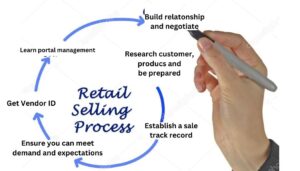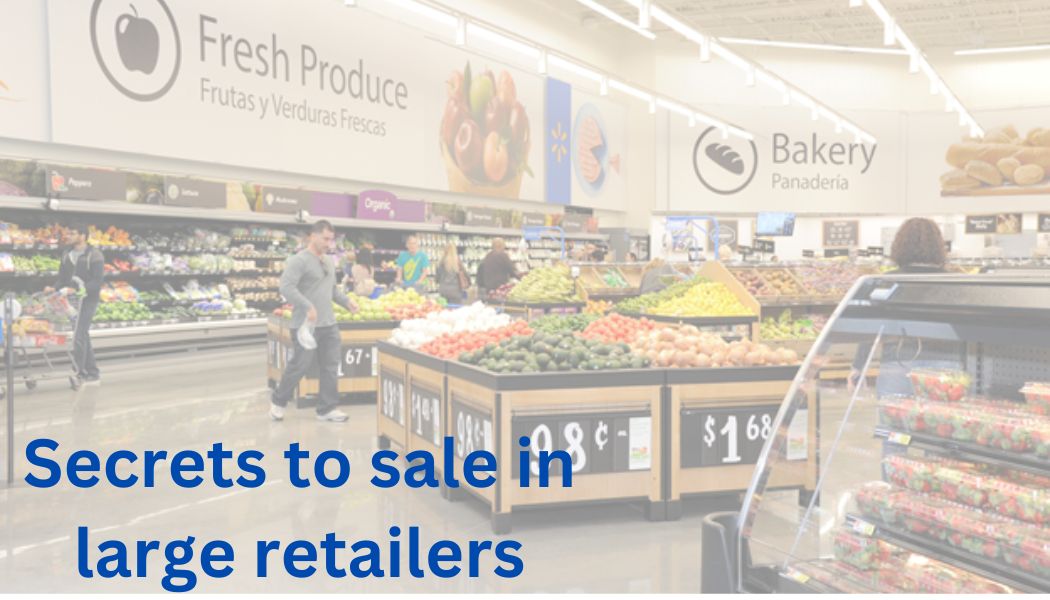For manufacturers, selling products in big retail chains like Walmart or Publix can present incredible opportunities and complex challenges. The potential for increased sales volume and brand exposure is undeniable, but breaking into these major chains requires careful planning, thorough preparation, and efficient management. In this article, I will explore the process of selling in large retail chains, offering insights and tips to help you successfully navigate this complex terrain.
Why selling in big retail chains is important
In today’s competitive marketplace, securing a spot in big stores can significantly impact a manufacturer’s sales and overall business growth. Let’s examine some compelling statistics that highlight the importance of accessing these major retail channels.
Sales volume: Big retailers, with their extensive reach and customer base, often dominate sales volume across various product categories. According to industry data, the top 10 retail chains in the United States accounted for approximately 43% of all retail sales in 2022. This statistic underscores the immense market influence and revenue potential of big chains.
Customer footfall and exposure: One of the primary advantages of selling in retail chains is the sheer volume of foot traffic these stores generate. For instance, Walmart alone attracts millions of customers everyday across its numerous locations. If you manage having products in these chains, you gain valuable exposure to a wide range of potential customers, greatly enhancing brand visibility and recognition
Increased sales and revenue: Research indicates that products available in big chains can achieve up to three times higher sales volume than those sold in regional or local stores. Manufacturers that manage selling in these chains have the opportunity to expand their customer base and revenue streams.
Market Penetration and Expansion Opportunities: Securing shelf space in big retail chains can be a gateway to expanding into new markets and reaching a wider audience. These chains often have a national or global presence, allowing manufacturers to tap into previously inaccessible regions and demographics. This market penetration potential can open up avenues for growth, increased market share, and long-term success.
Understanding the process
The process of selling in big retailers is very complex. The figure and text below provides a guideline of what you need to know to be accepted as a vendor in these big stores and start selling.

- Research and Preparation: Before approaching any big retail chain, it is crucial to conduct thorough research. Start by understanding the target market, demographics, and customer preferences of the retail chain you wish to sell in. This will help you align your product offerings and marketing strategies accordingly. You also need to understand the chain’s vendor requirements, guidelines, and processes to gain a comprehensive understanding of what it takes to become a supplier.
- Establishing a Track Record: Most of the big stores prefer working with established manufacturers with a proven track record of success. Therefore, it is often advisable to gain experience and build a customer base with smaller retail chains or local stores before approaching the giants. Demonstrating consistent sales volume, customer satisfaction, and quality products will enhance your chances of securing a vendor ID with the big chains.
- Meeting Supply Chain and Logistics Demands: Big chains operate on a massive scale and have stringent supply chain and logistics requirements. Ensure that you have the capacity and the ability to handle high-volume orders before approaching them. This includes having efficient production processes, reliable transportation, adequate warehousing facilities, and the funding required to support the process. Collaborating with third-party logistics providers can help streamline your supply chain operations.
- Vendor ID Acquisition: To sell in big retailers, you typically need to obtain a vendor ID. This identification number allows the retail chain to track and manage your products effectively. Each chain has its own process for acquiring a vendor ID, which may involve submitting detailed product information, financial records, certifications, and compliance documents. Be prepared to meet these requirements and provide any additional information as requested.
- Managing Portals and Compliance: Once you become a supplier to a big retail chain, you will need to manage their vendor portals and comply with their regulations and standards. These portals act as a centralized platform for order placement, inventory management, and communication. Familiarize yourself with the specific portal functionalities and ensure you have the necessary resources and systems in place to effectively manage your product listings, pricing, promotions, and compliance with various regulations.
- Building Relationships and Negotiating Terms: Establishing strong relationships with retail chain buyers is crucial for long-term success. Attend trade shows, industry events, and networking opportunities to connect with key decision-makers. When negotiating terms with big retail chains, consider factors such as pricing, payment terms, product placement, marketing support, and exclusivity agreements. Be prepared to negotiate and adapt your strategies to meet their specific requirements.
How Promoting USA can streamline the process of getting into big retail chains
Promoting USA has been servicing distributors and manufacturers for many years and we know the difficulties to start an operation in the US, or taking the next step into growing your business toward the big players. With the assistance of our “Retail Service Portal Management Team”, the time and investment in the acceptance process will be optimized.
I hope this article has been helpful to you. I will continue to post information related to trade channel management, general economy and market trends. If you are interested in this article or want to learn more about Promoting USA, please subscribe to stay updated on future articles.

